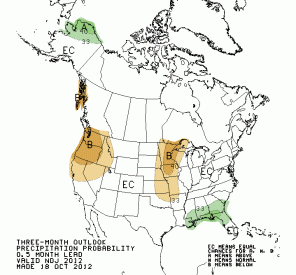
Fresh off our red flag fire warnings of late, late summer, Seattle has gotten almost three inches of rain in October. But don’t get used to it, cautions the Seattle branch of the National Weather Service. The trend is for a weak El Niño winter, or even a neutral winter, and that “indicates an increased likelihood of below-median precipitation for the Pacific Northwest.” A wildcard, they say, is the Arctic Oscillation, which could cool things off…or not.
Another caveat is that “below-median precipitation” doesn’t preclude floods from errant Pineapple Expresses.
University of Washington meteorologist Cliff Mass welcomes a neutral winter. Though very big storms are rare in the Northwest, he says, they tend to occur most often during neutral winters. Flourishing a plot-map, Mass announces:
The red squares indicate a major windstorm year (like the 1962 Columbus Day Storm or the 1993 Inauguration Day Storm). All of them are associated with temperature anomalies in the tropical Pacific between plus or minus one. This year will be in that range!
What were those storms like, you might ask, if you are newer to town, or to life in general. It’s all chronicled on the internet for you.
- Columbus Day Storm: In sheer gustiness of wind, as indicated by the ratio of maximum gust speed to sustained wind speed, called the gust factor, the Columbus Day Storm behaved more like a hurricane than a typical midlatitude cyclone
- Inauguration Day Storm: At least 79 homes were destroyed, 581 suffered major damage, and 1,702 experienced minor damage. Power was terminated to about 750,000 customers in the Puget Sound Area.
“I could show you a similar figure for floods or snowstorms, but that would only scare you,” concludes Mass, emphasizing once more, though, that a neutral winter doesn’t always bring this kind of excitement. (In the 47 years from 1949-50 to 1995-96, there were 14 neutral winters.) Most often, it brings what’s known as a “normal” winter, though with the weather acting as it has of late, you can be forgiven for not knowing what normal is anymore. Maybe the most reassuring thing is that whatever’s coming, with coastal radar, we’re better able to see it in time.
